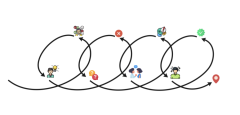My general research area is about the employment situation of art students. Eleanor (2018) said that the watchdog found that many colleges collected little data about the destinations of their students. Where data was available it was found that arts and media courses scored low in terms of employment prospects. Eva A (1993) stated that many of the respondents were expecting to have a difficult time after graduation, trying to accomplish multiple goals of getting admitted to a Graduate Art program, becoming a practicing artist, and finding a survival job.
For my primary research, I investigated the employment situation of my fine art classmates. The data shows that only 4% of people are doing an art-related job, while 17% have jobs entirely unrelated to their majors. 37% of them choose to be a teacher, and 15% of people are designers now.
In the beginning, my research data made me think that there are two main reasons for the difficult employment of art students. One is the nature of the major. Art major is a creative major and does not have a solid professional attribute. Kobe (2015) said that in uncertain economic times, any student graduating from university is no longer guaranteed a job. If this is true of students graduating with degrees in such career fields as business, law, and teaching, it is even truer in the creative field. The other reason is that some students don’t like this major, so it’s hard for them to stick with it and become an artist, and they change careers.
Subsequently, I questioned that whether there are any other reasons. After reading a few more articles about it, I came up with a few different reasons.
1) There is a mismatch between the number of art students and the number of jobs available. Eleanor (2018) argued that Arts and media does stand out as the area where there is the greatest mismatch between the numbers of students taking the courses and their future employment in the industry.
2) Art students lack of career counseling in their university. 82% of the art students felt that they had had inadequate career counseling in their schools, as compared with only 59% of the English students and 68% of the psychology students (Whitesel, 1980). Eva A (1993) said that having career information available in Art department offices and offering career-oriented Art courses to tell the student about what to do with a major in Art and how to prepare for that is essential. However, I think this point is a little outdated since these two articles were published 30 or 40 years ago. Nowadays, many universities set up career service centers for students to prepare their CVs or interviews.
3) Students who choose fine arts majors are mainly motivated by their interests, not by their future careers. Student interest in the subject is an important influence on major choice. Passion drive students’ lives and tastes for majors are a dominant factor in choosing specific majors by students (Jaradat, 2015). They had chosen their particular area of concentration in Art because of enjoyment in working with that medium, skill or familiarity with the medium, preference for the type of Art product created, better rapport with the professors, or preferences for the social structure in that area (Eva A, 1993).
4) The personality of art students leads to their limited choice of jobs. Eva (1993) claimed that the literature showed that Art students tended to have values systems and personality traits that might make working at certain jobs more difficult. Examples were not like a job that involved a boring routine or not liking to be a ‘pushy salesperson.’
Having analysed all of the points above, I now feel my topic is a complex topic with different reasons. My potential change has two directions. One is to make college students aware of choosing a major carefully by presenting employment problems. The other is to integrate resources to provide college students with a more comprehensive understanding—for example, the foundation course of UAL. But foundation courses are mainly for students who can afford it and are willing to spend a year exploring it. I would pay more attention to other student groups. Of the two directions, I personally prefer the first one. Because awakening students’ awareness is more valuable than providing information directly, if they have this awareness and are more careful and rational in their choice of major, they will always have a way to find relevant information.
Bibliography
Eva A, T., 1993. Program and Career Perceptions of Undergraduate Students Majoring in Fine Art. Ph.D. The University of Tennessee, Knoxville.
Whitesel, L., 1980. Career Attitudes of Art Students. Studies in Art Education, 22(1), p.36.
Eleanor, H., 2018. Arts students given ‘false jobs hope’ by colleges. Daily Mail, p.21.
Jaradat, M., 2015. What’s Really Matter When Choosing a College Major!. International Journal of Arts and Commerce, 4(2), p.94.
Bonita M, K., 2015. Entrepreneurship for the Creative and Cultural Industries. Abingdon, Oxon : Routledge.
